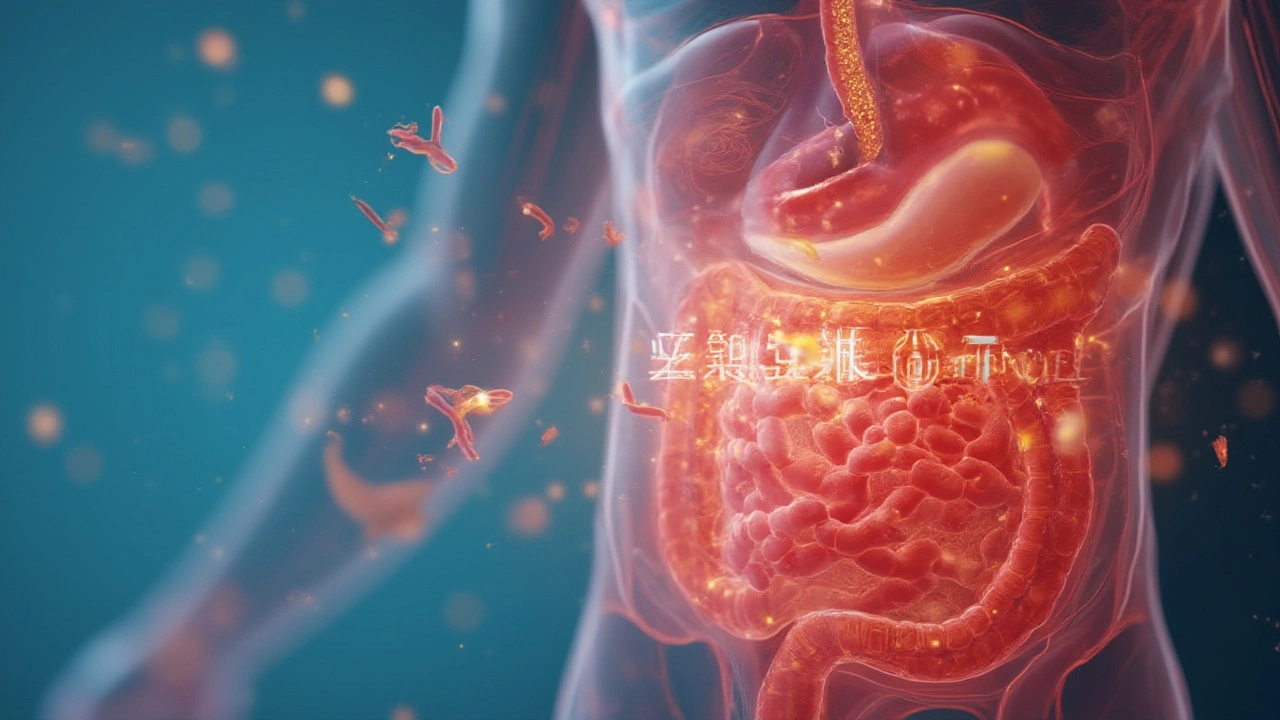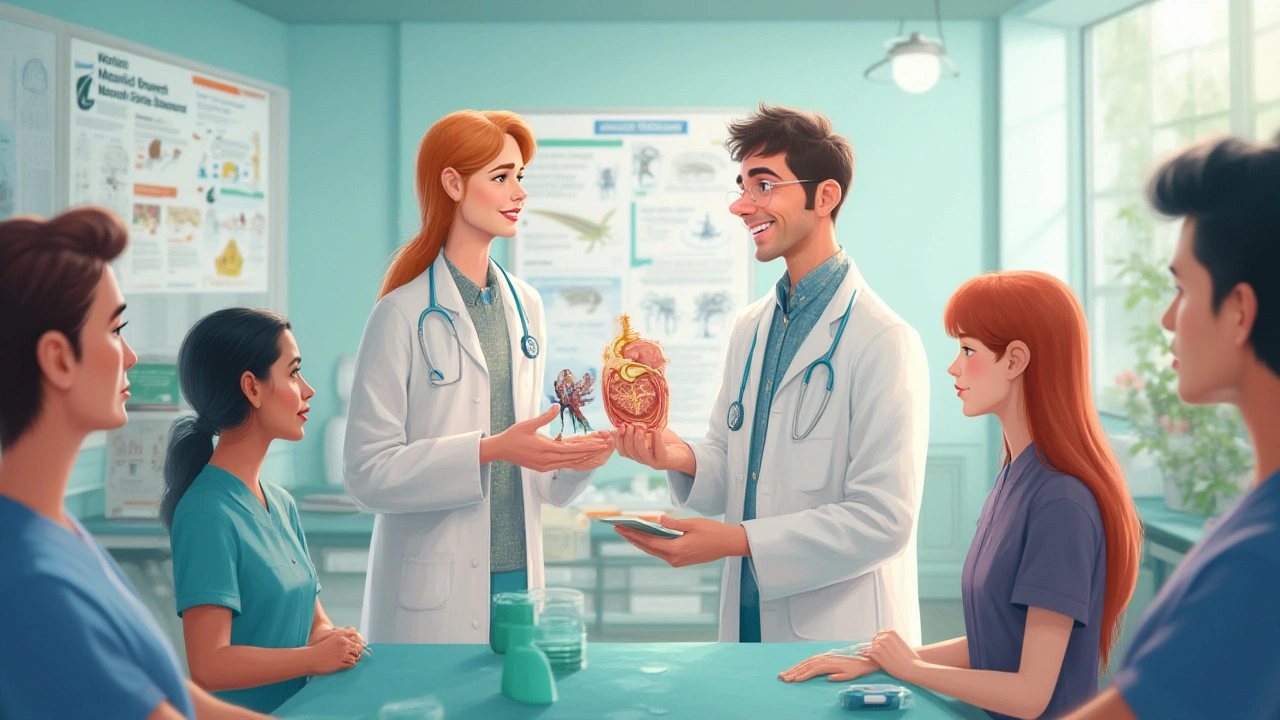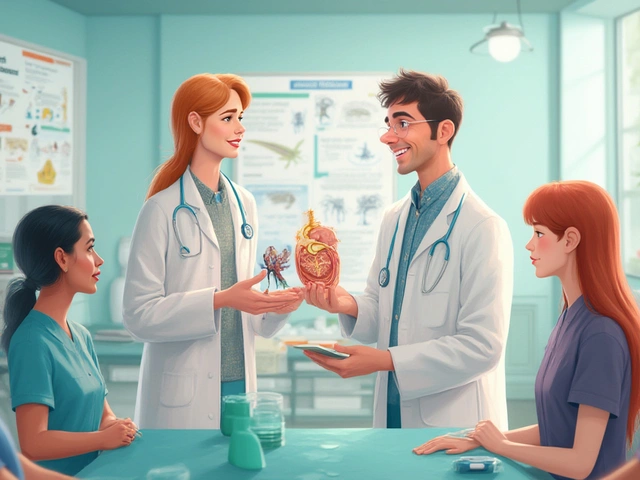It's wild to think a single small pill can knock out parasites that have been around since the dinosaurs. Biltricide is one of those meds: a legendary parasite-buster that’s quietly saved millions but rarely gets a headline. Think you’re safe from ever needing it? Imagine biting into grilled freshwater fish on vacation, or working where water isn’t exactly crystal-clear. Suddenly, you might want to actually know what Biltricide does, how it feels to take it, and what smart folks have learned about using it right.
What Exactly Is Biltricide and How Does It Work?
Pop into any pharmacy in the U.S. and ask for Biltricide, they’ll hand you a box stamped with the word "praziquantel." It’s not some new invention—it’s been around since the 1970s, discovered by Bayer and Merck. This is not a general de-wormer. It’s a highly specific weapon used to fight human schistosomiasis, liver flukes, and tapeworm infections like those you get from uncooked beef or pork. Each tablet packs a punch: 600mg of praziquantel. So, how does Biltricide knock those parasites out? Praziquantel doesn’t poison worms directly. Instead, it messes with their muscles. It causes worm muscle spasms, which throws the parasites into a state where they can’t cling to your intestines or tissues anymore. The worms lose their grip, become paralyzed, and your immune system finishes the job by flushing them out.
What’s really wild is that some of these parasite eggs and worms can hang out in the body for years before causing trouble. Biltricide is incredibly effective—which means after one round of pills (sometimes just a day), most people see dramatic results. It works for adults, teens, and even children as young as four years old. And it’s officially listed by the World Health Organization as an "Essential Medicine."
There are regional differences in how doctors use it. In places like Brazil, Biltricide is sometimes used as part of mass drug administration in communities with a high risk of schistosomiasis. In the U.S. and Europe, it’s more of a case-by-case tool, often prescribed after a positive stool or blood test. By the way, if you see the name "praziquantel" on a bottle outside the U.S., it’s the same stuff.
Doctors don’t hand these out like candy. They confirm the type of worm first with tests. It’s only for specific worm infections—most common roundworm or pinworm infestations (like the creepy-crawly ones kids pass at daycares) are actually treated with other meds entirely. It’s best for serious stuff: schistosomiasis, certain liver and intestinal flukes, and tapeworms from fish, pork, or beef. These parasites usually live in parts of Africa, South America, and Asia, although every year, a handful of tourists bring them home as souvenirs.
| Parasite | Common Location | Transmission | Biltricide Effective? |
|---|---|---|---|
| Schistosoma species (blood flukes) | Africa, Middle East, S. America, SE Asia | Contaminated freshwater | Yes |
| Taenia saginata (beef tapeworm) | Worldwide | Undercooked beef | Yes |
| Clonorchis sinensis (liver fluke) | China, Korea, Vietnam | Raw freshwater fish | Yes |
| Fasciola hepatica (sheep liver fluke) | Worldwide (esp. sheep/cattle) | Contaminated water/plants | No |
| Roundworm/pinworm/hookworm | Global | Contaminated soil | No |
Common Uses: When and Why Doctors Reach for Biltricide
Not every strange stomach ache needs Biltricide. This stuff is reserved for the kind of parasites that textbooks label as "tough customers." Schistosomiasis is a big one—it infects about 200 million people worldwide, mostly in areas with untreated freshwater. Liver flukes, on the other hand, come from eating raw, freshwater fish—a huge issue in places like China and Thailand. Tapeworms? You’d typically pick one up from undercooked beef, pork, or (if you’re adventurous) certain types of raw or marinated fish.
So how do you know if you need Biltricide? Most people don't even realize they have parasites at first. They might notice fatigue, diarrhea, weight loss, or weird, unexplained stomach symptoms months after a trip or after eating something suspicious. Tapeworms sometimes make themselves known via their body segments in poop. Liver flukes and schistosomes, though, can fly under the radar for months. Weirdly enough, sometimes the only clue is elevated liver enzymes on a blood test.
Doctors will often use a mix of tests: stool samples (eggs or tapeworm segments), blood tests (looking for parasite antibodies), imaging scans, or even ultrasound for certain fluke infections. Once they've figured out what bug is responsible, that's when Biltricide enters the chat. It’s rarely the first medicine used if the diagnosis is unclear, because it targets a narrow group of troublemakers.
- Schistosomiasis: Usually two or three doses of Biltricide in one day. Kills adult worms but not immature forms—doctors may repeat treatment after a few weeks.
- Liver Flukes: Slightly higher, repeated doses. You need to break past the tough outer layers of these flukes. Response is often dramatic—people feel better within days.
- Tapeworms: One dose typically works. Patients usually pass the worm in stool a day or two later—kind of gross, but satisfying if you know the thing is gone.
- Unusual Flukes (Paragonimus, Opisthorchis): Special dosing plans, sometimes with a second medicine.
Travel clinics and hospitals in big cities keep Biltricide on hand for returning travelers. But if you've been to a rural lake in Africa, eaten carp sushi in Vietnam, or worked in areas with questionable water sanitation, it pays to bring up your risk factors with your doctor. Don’t wait for symptoms to show up—early detection can save your liver, your digestion, even your brain (some tapeworms can migrate to the brain and cause seizures!).
Never self-prescribe praziquantel you get off the internet. Counterfeit pills are everywhere, and taking it wrongly (wrong dose or for the wrong worm) can leave you sicker than before.

Dosage, Timing, and How to Take Biltricide Properly
Those little oblong tablets look harmless, but getting the dose right is a big deal. Dosage depends on your weight, the bug you’re fighting, and sometimes even your age or overall health. Adults and kids over four generally get similar doses, adjusted for pounds or kilograms. The most typical setup? Doctors give three doses in a single day, spaced out about 4–6 hours apart. Liver fluke infections may need three days of dosing instead of just one.
Always take Biltricide with a meal, preferably something with some fat in it—a slice of toast with butter, or a glass of milk works well. Fat in your stomach helps your body absorb more of the medicine. Swallow the tablets whole; they are bitter if chewed or crushed (like, grimace-bitter).
- Don’t miss a dose. Timing matters for maximum kill rate.
- If you throw up within an hour of taking a dose, call your doctor. You may need to repeat that dose.
- Don’t lie down for about 30 minutes after swallowing the tablets. This lowers the risk of reflux or nausea.
- Bring a friend or family member if you’re worried—Biltricide can make some folks drowsy or dizzy.
Your doctor might suggest a follow-up stool or blood test weeks after treatment to check that the parasites are really gone. Sometimes, a second round of treatment is needed, especially if you live in a region where reinfection is common. That’s why the World Health Organization sometimes runs "mass treatment" programs in schools and communities—one round isn’t always enough if the water stays contaminated.
Watch out for interactions: Praziquantel gets processed by the liver, and certain anti-seizure meds, antibiotics, or even grapefruit juice can reduce its effect. If you take anything beyond basic vitamins, tell your doctor. Pregnant or breastfeeding? Most experts think Biltricide is safe, but doctors still weigh the risks and benefits before writing a script.
| Condition | Typical Dosage (Adults) | Duration |
|---|---|---|
| Schistosomiasis | 20 mg/kg x 3 doses | 1 day |
| Liver Fluke (Clonorchis/Opisthorchis) | 25 mg/kg x 3 doses | 1 day |
| Tapeworm | 5–10 mg/kg x 1 dose | 1 day |
Tools like weight calculators and dose charts help doctors avoid mistakes. If you get Biltricide outside the U.S., pills sometimes come in different strengths or with different labeling—always double-check to avoid under- or overdosing.
Side Effects: What Most People Feel (and a Few Rare Surprises)
Most people get away with nothing worse than a sour stomach or a headache, and that’s a very good thing. Still, you should know what to expect. Nausea, loose stools, mild cramps, and temporary fatigue are the biggies. Some people feel a little dizzy, or notice their skin feeling itchy or bumpy for a day or so—usually a sign your immune system is clearing out the worms. For the vast majority, these symptoms peak within 24-48 hours and then fade quickly.
- Nausea or upset stomach (up to 30% report this)
- Headache (10–20%)
- Drowsiness, mild dizziness (5–10%)
- Liver enzyme spikes—rarely, labs show temporary increases, which return to normal
- Allergic rash—even more uncommon, call your doctor if you break out or swell up
One weird thing: Sometimes, the symptoms from clearing the infection feel worse than the infection itself. As Biltricide wipes out the worms, you can get what's basically a mini "Herxheimer reaction"—fever, chills, body aches. It's the parasites dying off fast and your immune system mopping up. Usually, this doesn’t last long, and you’ll feel a rapid bounceback. Taking the meds with food and lots of water usually tames most side effects.
Rare surprises? Extremely rarely, people with heavy parasite loads get more intense symptoms: seizures if tapeworm larvae were in their brain (neurocysticercosis), or severe inflammation in the intestines. That's why doctors sometimes give anti-inflammatory steroids alongside Biltricide in high-risk cases. If you already have liver problems, your medical team will watch your labs closely—massive worm die-off can put extra pressure on a sick liver.
No medicine is perfect, but compared to older treatments (some involved arsenic or harsh chemical baths), Biltricide is a game changer. Most get by with only mild, short-term issues. If you’re unlucky and wind up with one of the rare bad effects, don’t tough it out—get seen fast. Most problems can be sorted quickly with the right care.

Smart Tips for Taking Biltricide Safely (and Avoiding Reinfection)
Real talk: The best way to avoid these parasites is to avoid their favorite hangouts and habits in the first place. But life and travel rarely stick to the safest script. If you do wind up needing Biltricide, there are some things you can do to make the process smoother—and keep worms out for good.
- Finish the entire course, even if you feel better after the first dose. Half-treated worms can stick around and come roaring back.
- Stick to the timing. If the doctor says every 6 hours, set an alarm—don’t guess.
- Bring up every med or herb you take with your pharmacist. Certain fungal or seizure drugs mess with Biltricide’s effectiveness.
- Eat before and after your dose to cut nausea. Bland food rules: crackers, toast, rice.
- See your doctor for a follow-up test 2 to 4 weeks later, especially if your infection was severe or complicated.
- Share your travel and food history honestly. Don’t be embarrassed—doctors have heard worse. Details help them nail down the right diagnosis and avoid missteps.
How to avoid getting infected again? Cook meat and fish thoroughly, especially after trips to high-risk countries. Skip raw freshwater fish. Avoid swimming or wading in lakes or rivers in Africa, Southeast Asia, and South America unless you know the water is safe. Wash produce with clean, running water. Don’t rely on bottled drinks alone if you’re staying long term; learn about the local water risks.
There are public health programs that use Biltricide to protect whole communities in risky regions. For travelers, ask your doctor about parasite risks before you leave. If you're a parent and your kids attend school in an outbreak area, participate in community screenings; early detection saves a lot of drama.
It’s easy to take modern medicine for granted, but Biltricide is proof that science can tackle even ancient, hard-to-see problems. People who’ve beaten a tough parasite will tell you: relief comes quick, and it’s a life-changer. Learn what you can about smart medicine use now, and you’ll thank yourself for it if you ever see a worm segment after lunch—or just want to keep your liver out of trouble later.







